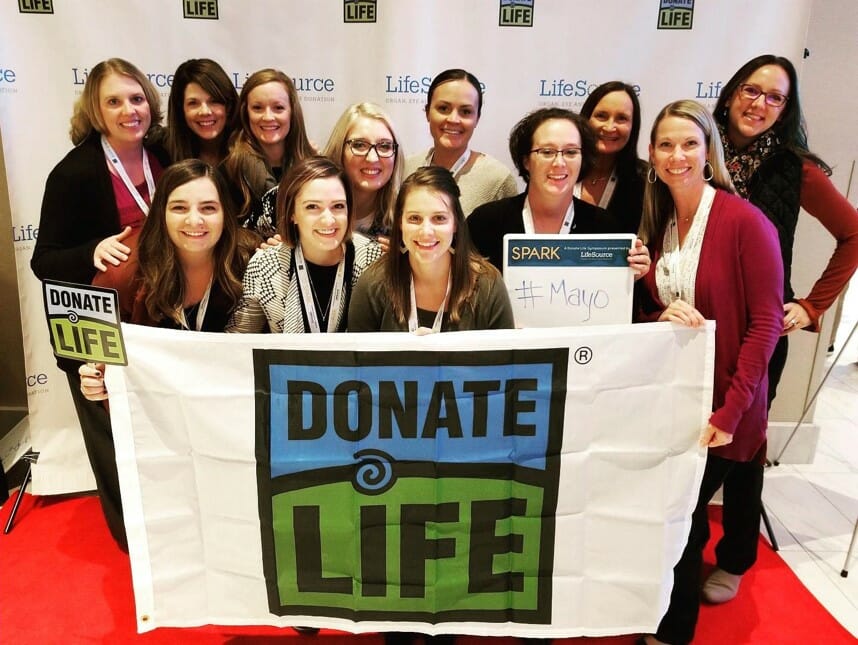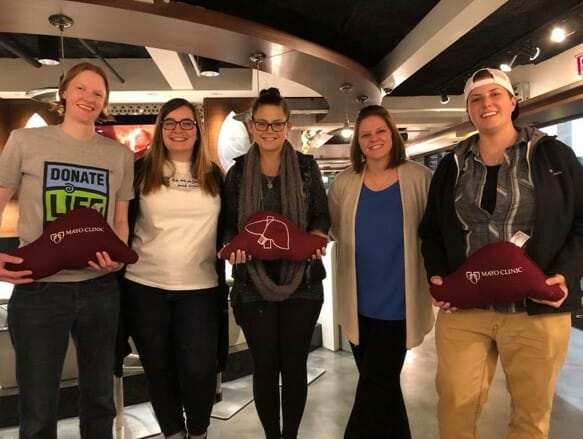Mayo Clinic Nurse Shares Organ Transplant Experience
Registered nurse, Emily Readle shares her experience caring for patients waiting for an organ transplant.

Emily Readle, R.N., C.M.S.R.N., CHPN, is a LifeSource Donate Life Ambassador and Registered Nurse at Mayo Clinic in Rochester, MN. She spent the first four years of her nursing career working with solid organ transplant patients and transitioned to palliative care in 2018. Emily shares her experience witnessing the power of donation and transplantation, and the beauty of caring for patients and their families in times of need.
I grew up in a small town and went to a small university in Indiana. My nursing clinicals were primarily in small, rural hospitals. Big surgeries, like transplants or specialty care would be referred out to the bigger cities, so my exposure was fairly limited to basic medical/surgical nursing. When I was looking for jobs after undergrad I was willing to try any kind of nursing as I hadn’t yet found my passion. I ended up applying for and accepting a job in solid organ transplant at Mayo Clinic in Rochester (where I had done an internship) with the plan to work a couple of years and try to sort out what I was really interested in and what I wanted to do with my life. I didn’t know it then, but my life was about to be changed forever. My years working in transplant would shape the person I am today, both personally and professionally.
There are no words that can adequately describe the honor that is walking alongside a patient and their family through their transplant journey.
Because most of my patients would be in and out of the hospital frequently or hospitalized for months while awaiting transplant, I would get to know them and their families well. I helped patients through some of their worst and sickest days, and at times it felt like we would never find a donor match for them. There was nothing more exciting than hearing that a patient was coming in for a transplant, or a being in the room when the doctor shared that a match had been found. The excitement was palpable. As a nurse, there was nothing more rewarding than seeing your patient become healthy and learn to live a normal life again. Patients would stop by the unit when they were back in town for appointments, and they were often unrecognizable because they were so healthy and thriving. And every time, these patients expressed their gratitude for the gift of life they were given by their donors.

After a few years of working in solid organ transplant, I decided to become a LifeSource Ambassador. While I don’t fit into the typical group of “donor family” or “recipient,” I was motivated and inspired by the hope of new life I saw each day in my transplant patients. After learning that 90% of Americans believe organ donation is a good thing but the national average of those registered as donors is between 50-60%, I knew that there was more work to be done. I knew that I could play a small role in providing education, bringing truth to the myths, and encouraging folks to become donor designated. One of the most shocking things to me was how many of my own colleagues did not know if they were registered as a donor or thought they were registered and actually were not. If this was happening for transplant nurses, I could only begin to imagine how many other people were supportive of being registered but were not.
I reflect on my time as a transplant nurse often and vividly remember so many of my patients. I think about *Tim, the father of two young children and husband to the most kind and wonderful wife. He has had two transplants, one from a living donor and one from a deceased donor. He’s now several years out from his transplant and thriving. He’s able to be an active dad and attentive husband. He’s back to teaching elementary school and impacting the lives of his students each day.
I think about *Tammy, who had been on dialysis three times a week for four years and was given the gift of life through a kidney transplant. Her whole world is different now because of the gift of organ donation. She no longer spends her days in the dialysis center or recovering from dialysis, but instead gets to spend time with her family and friends.
And I think about *Kyle, who received a liver transplant. After some time, Kyle was diagnosed with an unrelated type of metastatic cancer that unfortunately took his life. I cared for Kyle often over several years and his family gave me the honor of walking with his pallbearers at his funeral. It was a devastating loss for Kyle’s family, but at his funeral, his family shared that without his liver, he would not have been given the three extra years with his family, who celebrated and cherished every extra day they had with him.
When I think about why I choose to continue advocating for organ donation, I think about the hundreds of Tims, Tammys, and Kyles who are given the gift of life through the heroic and selfless choice of organ donors and the work that is done by the LifeSource team.

In my work as a bedside nurse, I found myself gravitating towards caring for patients who were nearing the end of life. In 2018, I transitioned to palliative care. I had been drawn to palliative care anytime the team visited my patients. They helped people feel better from a whole-person perspective and I was so impressed that each time they entered a room, the whole team took a seat and provided the patient with the time, space, and energy that they needed and deserved. My job in palliative care now gives me the time to be present with my patients whether it’s on the day they receive a diagnosis or as they near the end of their life. It isn’t always easy work, but there is something truly sacred about patients and families allowing you into some of their most difficult days and the honor of walking alongside of them.
When I transitioned to palliative care, I had not considered the likelihood that I might also care for patients who may become organ, eye or tissue donors. It has been such a joy and honor to care for patients at the intersection of palliative care and organ donation. I see hope for families as they find meaning and comfort in knowing that their loved one’s legacy will live on through donation.
*Patient names have been changed
 Skip to main content
Skip to main content
